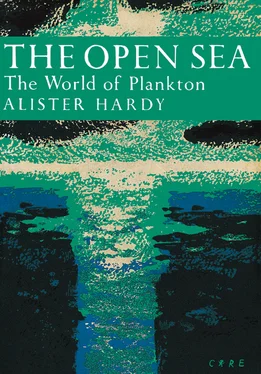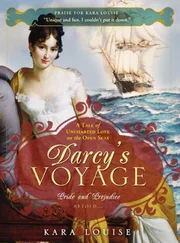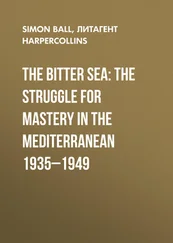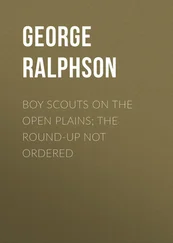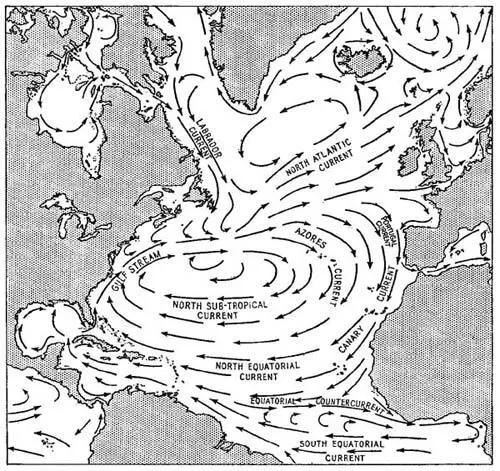
FIG. 2
The surface currents of the North Atlantic Ocean. Drawn, with kind permission, from Admiralty Chart No. 5310 (1949), omitting some of the detail.
The general systems of the surface currents of the world have been worked out largely from the innumerable observations of navigators. Suppose a ship steers from point A on a particular course by compass which should carry it to a point B in, say, a day’s time; if at the end of the 24 hours the navigator finds by reference to the sun or stars that he has instead reached a point five miles to the south-east of it, then if there is no wind to account for his drift he knows that the surface water must be flowing in a south-easterly direction at a speed of five miles a day. The great pioneer in organising a systematic recording of winds and ocean currents throughout the world was Lieut, (later Admiral) M. F. Maury of the United States Navy who wrote the first text book of oceanography, The Physical Geography of the Sea in 1855, to be followed by many editions. The charts he produced of the wind and current systems of the world rendered immense service to commerce; before their production the average time of sailing between England and Australia was 124 days, but with their use it was reduced to 97, or the average passage to California (presumably from New York) was 183 days and this was reduced to 135 (from Maury, loc. cit.).
FIG. 3
Types of drift-bottle for investigating ocean currents, a , surface drifter, old type; b , bottom drifter; c , surface drifter, modern type; for further explanation see text.
Observations on the movements of ships are suitable for indicating the surface drift only in the wide open oceans. For working out the current systems in more detail in more confined areas science has made use of that romantic object, the shipwrecked sailor’s bottle with a message to his home. Thousands and thousands of these drift bottles have been cast into the sea at many different points. Each bottle displays through its glass sides, a notice in several different languages asking the finder to break it and read the instructions within; these tell him that if he will fill in and send off an enclosed postcard giving particulars of the place and date of recovery, he will receive a small reward. Many hundreds of these cards have been returned from various points along the coasts of different lands. In this way Dr. T. W. Fulton of the Scottish Fishery Board first charted the main surface movements of the North Sea at the beginning of the century. Later Dr. G. P. Bidder introduced bottom-drifting bottles, each provided with a trailing wire and weighted so as to drift along with this just touching the sea-bed; these are designed to be recovered by the many trawlers dragging their nets along the bottom of the North Sea and English Channel. Thus knowledge has been gained not only of the surface currents but also of the movements of the lower layers of water, which are often very different. Objects floating on the very surface of the sea may be driven by the wind much faster than will the true upper layer of water; surface drift bottles have now been improved by Dr. J. N. Carruthers (1928) who has provided them with little weighted ‘sea anchors’ to keep them drifting with the main body of water. Sketches of these different bottles are shown in Fig. 3and an example of their use in studying the drift of plaice eggs is shown in Fig. 5. Quite recently oceanographers have started using water-proof plastic envelopes instead of bottles.
FIG. 4
Diagrammatic sketches showing the working of the Ekmann current-metre.
For the more exact measurement of the speed and direction of current flow at different depths special instruments have been invented to be used from anchored ships. One of the most successful is that of Dr. Ekmann. It is such a beautiful and ingenious device that it is worth examining in some detail to see how it works. It is suspended in the sea on a wire, as shown in Fig. 4, and, being provided with a vane like a weather-cock, always points head on into the current. It also has a little ‘propeller’ which will be turned by the water flowing past it; this however is held by a catch until the measurement of flow is about to begin. On the underside of the apparatus, and held horizontally, is a circular box, like a large and rather deep pill-box. The lower half of this is divided into a number of compartments by partitions radiating from the centre like the spokes of a wheel; swinging above these compartments, and pivotting upon a spike in the centre, is a stout compass needle having a slightly sloping groove on its upper surface running from its mid-point to the end pointing to the north. In addition the compass box has a small hole in the centre of the lid and immediately above it is another little box containing a supply of bronze shot. To take a current measurement the instrument is lowered to the desired depth—perhaps 10, 50 or 100 metres; then a small brass weight, called a messenger, is threaded on to the suspending wire and sent sliding down to release the catch and set the propeller free to turn. After one, two or more hours as may be desired, the recording is ended by the dispatch of a second ‘messenger’, which moves the catch further over to stop the propeller once more, and the machine is hauled up to the surface. The number of turns the propeller has made in the interval of time is recorded on a series of little dials and so enables the speed of the current to be estimated; also after every so many revolutions a little valve opens and allows a shot to drop into the box below and be guided by the grooved compass-needle into one of its compartments. The compass-box, being fixed to the instrument, is always orientated in relation to the direction of the current; thus as the instrument swings in response to changes in current flow, each shot is dropped into whatever compartment happens to lie below the north-pointing end of its compass needle. By counting the shot found in each of the compartments at the end of a recording we know to what extent the current has varied during the time of observation and also the average direction of its flow. The direction is, of course, given by the angle between the mid-line of the box and that of the compartment which most often pointed north, as revealed by the shot in it. Such observations are made at several depths to show how the speed and direction of the water flow varies at different levels.
The upper layers of sea are nearly always travelling faster than the lower ones. The surface layer is affected by the wind; apart from this, however, the lower layers will be retarded by the frictional resistance of the sea-bed, just as in a river the water in the middle travels faster than that near the bank. We shall later see ( see here) that these differences in speed may have a marked effect on the distribution of plankton animals which make extensive day and night migrations between the upper and lower layers. In deep ocean basins we may even find currents at different levels flowing in opposite directions.
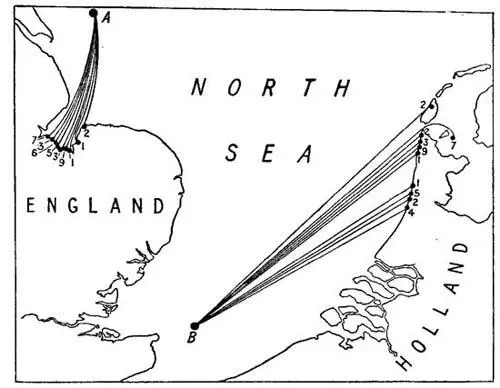
FIG. 5
Showing where drift-bottles liberated at A and B were recovered. A map reproduced from one in the museum of the Fisheries Laboratory at Lowestoft showing the results of one of many experiments made by the late Mr. J. O. Borley when investigating the drift of plaice eggs and larvae from the spawning areas to the coastal nursery grounds. The numerals show the number of bottles picked up at each point.
Читать дальше
